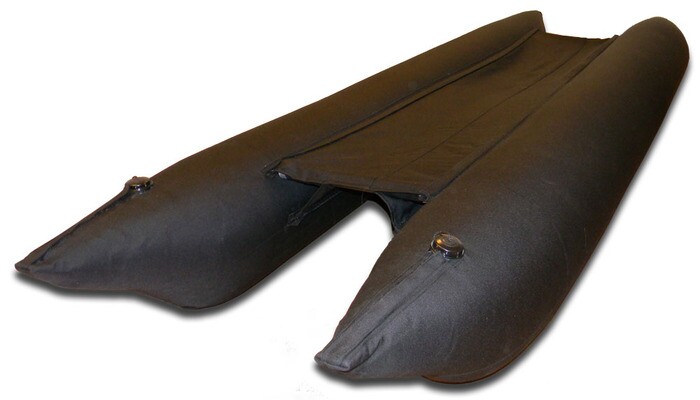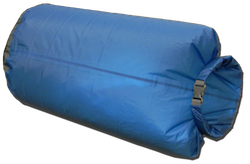Built to empower new adventures, the Trekkayak lets one hike deep into the wilderness and paddle his or her way back out. Joining a market of light, portable water sports gear that includes packrafts and seatrekking backpacks, the Trekkayak is an inflatable catamaran that packs fast and light in your backpack. When you get to water's edge, you simply unpack the boat, inflate it and paddle your way back home.
Over the past decade or so, the sport of packrafting has grown in visibility and popularity thanks largely to the rugged, ultralight, inflatables built by Alpacka Raft, which launched in 2001. The rafts pack up small and light, allowing the paddler to throw them in a backpack and venture out to distant bodies of water and create multi-sport expeditions that intertwine paddling and activities like hiking and biking.
"My favorite use for packrafts is crossing wild landscapes where rivers run free and the only trails crossing the country are made by wild animals," writes Roman Dial, explaining the allure of the sport in his book Packrafting! An Introduction and How-To Guide. "It is there, when I grow tired of walking, that I can boat, and when I grow tired of boating, I fold up my raft and hike over the ranges to another river to paddle again. For me, the best trips mix mountain and water wilderness over many days to weeks, where I am accompanied by good friends and wildlife."
The Swedish innovators behind the Trekkayak were familiar with that type of call of the wild, and in seeking to answer it, they used a variety of traditional packrafting gear. In fact, they admit to liking Alpacka rafts and to considering them a benchmark-level product. However, along their travels, they identified different needs in a packable boat, and designed the Trekkayak as a solution.

The Trekkayak is quite similar in spirit and inspiration to the packraft, but it takes on a new form. Instead of the oblong flotation tube with hollowed out deck, the Trekkayak features dual hulls, each with an inner polyurethane bladder and outer Cordura skin. A separate piece of Cordura spans the hulls and serves as the seat, allowing the paddler to sit above the water. Two detachable carbon fiber connecting rods between the hulls add extra structure and stability. The seat fabric attaches by way of a "crocodile" Velcro system, which appears to be a dual flap clamped down on a two-sided Velcro seat edge.
In addition to pulling the rider above the coldness of the water below and protecting his "noble parts" from unwanted contact with jagged rocks, the Trekkayak design offers several claimed advantages. Trekkayak's Kurt Sjöblom tells us that the dual hulls give the vessel more directional stability when compared to a raft and more stability when compared to a kayak. He also says that the boat is easier to paddle thanks to the sharp paddle angle it requires and added speed of the dual-hull build.
In addition to increased on-water performance, the dual hulls are designed to provide some safety and maintenance benefits. They add redundancy; if one pops, there's still another one there to help you stay afloat and make it back to shore. The two individual hull layers are built to provide rugged use in the water and allow for easier field repair via replacement of the inner bladder instead of patching. Similarly, the Trekkayak features screw-in valves in place of glued valves to expedite in-field replacement.
In its current prototype form, the Trekkayak weighs 6.6 lb (3 kg) and packs down to a size of about 19.7 x 13.8 in (500 x 350 mm), sliding into the accompanying dry sack. The dry sack doubles as the inflation mechanism, blowing the vessel into its 9.8 x 3-ft (3 x 1-m, L x W) form within a few minutes. The boat can carry up to 485 lb (220 kg), with the 6.6-ft-long (2-m) seat providing enough room for one or two, depending upon their size and the amount of gear.

Trekkayak designed its craft with the intention of modularity. While modular accessories and add-ons haven't been engineered yet, the removable seat was made with the idea of substituting different fabrics for different applications. For instance, you could use an ultralight fabric seat to save weight, a heavier fabric for rougher water and a wider layout for carrying more gear. Trekkayak also mentions possibilities like a spray deck, different hull sizes and a motor mount. The hull and seat MOLLE webbing will be used for these future Trekkayak-specific accessories, as well as for attaching standard gear and accessories.
The Trekkayak is larger than the average Alpacka two-person packraft, but it's also a bit heavier than the ~5- to 6-lb (2.27 to 2.72-kg)) range of those boats. Its size and weight are favorable when compared to packrafts from other brands, such as NRS and Kokopelli Raft Co, but features and designs vary greatly. On paper, the Trekkayak looks like a solid portable inflatable for those that prefer a catamaran over a raft.
Trekkayak is currently working to raise development funding on Kickstarter. The SEK4,455 (US$600) early bird pledge point has already gone, but still has more boats at the SEK5,200 (US$700) early bird level. Those early bird prices are cheaper than packrafts of similar size, while the listed SEK8,910 ($1,200) "preorder special" is more in line with the competition. Trekkayak has already surpassed its goal, and if the rest of its plans work out, it will begin early bird deliveries in April.
Source: Trekkayak










